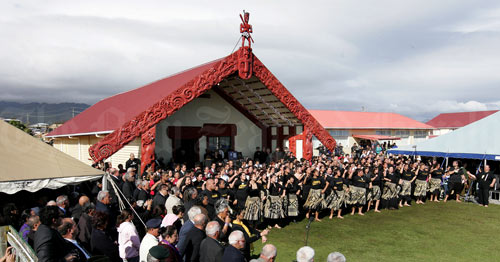POWHIRI


A Powhiri is a Maori process where the tangata whenua (hosts) welcome the manuhiri (guests) on to their pa site or marae. There are many different people and procedures that need to be carrried out in a powhiri which I will explain later in this passage.
Tangata Whenua
 The Tangata whenua or hosts are the people welcoming the manuhiri or guests onto their marae or pa site.
The Tangata whenua or hosts are the people welcoming the manuhiri or guests onto their marae or pa site.
Manuhiri
The Manuhiri are the guests onto the marae when the powhiri is being performed there are sometimes different names for this manuhiri for example the visitors to a marae who have never been there before are known as waewae tapu . Distant visitors are known as manuhiri tūārangi . When manuhiri have never been to a particular marae before a kaumātua in the group will often perform a protective karakia or prayer known as a waerea. When coming onto the marae the manuhiri then give the tangata whenua a koha or gift.
Koha or Gift
The koha is a gift by the manuhiri to the tangata whenua. It is usually placed on the ground by the final speaker from the manuhiri. Once the speaker is seated someone from the tangata whenua will pick it up.
Wero or Taki
In modern times a wero or taki occurs when a particular important visitor is being welcomed. A full challenge involves three challengers, who are warriors. The rakau whakaara is laid down by the first challenger. After it is picked up by the hounoured guest the challenger turns and returns to his people. Then the rakau takoto is laid down by the second challenger and is picked up by the guest. The third challenger kneels and lays down the rakau whakawaha, which is also picked up by the guest. This challenger then leads the party onto the marae.
Karanga
In many, there will be no wero and the Powhiri will begin with the karanga or call. A kaikaranga from the tangata whenua will begin to call and she will be responded to by a kaikaranga from the manuhiri. The manuhiri will move onto the marae and the calling will continue.
The Manuhiri are the guests onto the marae when the powhiri is being performed there are sometimes different names for this manuhiri for example the visitors to a marae who have never been there before are known as waewae tapu . Distant visitors are known as manuhiri tūārangi . When manuhiri have never been to a particular marae before a kaumātua in the group will often perform a protective karakia or prayer known as a waerea. When coming onto the marae the manuhiri then give the tangata whenua a koha or gift.
Koha or Gift
The koha is a gift by the manuhiri to the tangata whenua. It is usually placed on the ground by the final speaker from the manuhiri. Once the speaker is seated someone from the tangata whenua will pick it up.
Wero or Taki
In modern times a wero or taki occurs when a particular important visitor is being welcomed. A full challenge involves three challengers, who are warriors. The rakau whakaara is laid down by the first challenger. After it is picked up by the hounoured guest the challenger turns and returns to his people. Then the rakau takoto is laid down by the second challenger and is picked up by the guest. The third challenger kneels and lays down the rakau whakawaha, which is also picked up by the guest. This challenger then leads the party onto the marae.
Karanga
In many, there will be no wero and the Powhiri will begin with the karanga or call. A kaikaranga from the tangata whenua will begin to call and she will be responded to by a kaikaranga from the manuhiri. The manuhiri will move onto the marae and the calling will continue.
Whaikōrero
Whaikōrero are given by both hosts and visitors on the marae
At the conclusion of each speech the speaker and a number of supporters will sing a waiata . Often these are traditional waiata.
Harirū and hongi
At the conclusion of the formal proceedings the manuhiri will be invited to come and hongi and harirū with the tangata whenua. Traditionally, whether male or female, participants would hongi. After European settlement, the kiss was introduced, and instead of a hongi men and women would kiss other women. Many marae now insist on a return to the traditional method where only hongi and harirū occurs.
Hākari
The pōwhiri will conclude with a hākari , which lifts the tāpu of the pōwhiri.
Poroporoaki
The conclusion of a hui will be marked by formal farwells known as poroporoaki. It is usual for the manuhiri or visitors to initiate the poroporoaki. This is because it is considered good etiquette to let the visitors leave when they are ready, and impolite for the hosts to tell them to leave. Poroporoaki generally happens in the wharenui at the conclusion of a hakri but are also held, more rarely on the marae atea.
.
https://www.youtube.com/watch?v=fag_MhKByhA
No comments:
Post a Comment